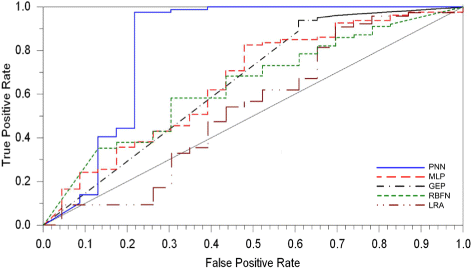Prediction of 5-year overall survival in cervical cancer patients treated with radical hysterectomy using computational intelligence methods
- PMID: 29233120
- PMCID: PMC5727988
- DOI: 10.1186/s12885-017-3806-3
Prediction of 5-year overall survival in cervical cancer patients treated with radical hysterectomy using computational intelligence methods
Abstract
Background: Computational intelligence methods, including non-linear classification algorithms, can be used in medical research and practice as a decision making tool. This study aimed to evaluate the usefulness of artificial intelligence models for 5-year overall survival prediction in patients with cervical cancer treated by radical hysterectomy.
Methods: The data set was collected from 102 patients with cervical cancer FIGO stage IA2-IIB, that underwent primary surgical treatment. Twenty-three demographic, tumor-related parameters and selected perioperative data of each patient were collected. The simulations involved six computational intelligence methods: the probabilistic neural network (PNN), multilayer perceptron network, gene expression programming classifier, support vector machines algorithm, radial basis function neural network and k-Means algorithm. The prediction ability of the models was determined based on the accuracy, sensitivity, specificity, as well as the area under the receiver operating characteristic curve. The results of the computational intelligence methods were compared with the results of linear regression analysis as a reference model.
Results: The best results were obtained by the PNN model. This neural network provided very high prediction ability with an accuracy of 0.892 and sensitivity of 0.975. The area under the receiver operating characteristics curve of PNN was also high, 0.818. The outcomes obtained by other classifiers were markedly worse.
Conclusions: The PNN model is an effective tool for predicting 5-year overall survival in cervical cancer patients treated with radical hysterectomy.
Keywords: 5–year overall survival; Cervical cancer; Computational intelligence methods; Probabilistic neural network.
Conflict of interest statement
Ethics approval and consent to participate
This research is involved with human participants and is approved by the Bioethics Committee of the Regional Medical Chamber (reg. no. 3/98; 20/02/1998).
Consent for publication
Each patient participated in the current study under the ’Ethics, consent and permissions’ heading based on Bioethics Committee approval. This manuscript does not include an individual participant’s data in any form (including images, videos, voice recordings etc).
Competing interests
The authors declare that they have no competing interests.
Publisher’s Note
Springer Nature remains neutral with regard to jurisdictional claims in published maps and institutional affiliations.
Figures
Similar articles
-
Application of gene expression programming and neural networks to predict adverse events of radical hysterectomy in cervical cancer patients.Med Biol Eng Comput. 2013 Dec;51(12):1357-65. doi: 10.1007/s11517-013-1108-8. Epub 2013 Oct 18. Med Biol Eng Comput. 2013. PMID: 24136688 Free PMC article.
-
Prediction of 10-year Overall Survival in Patients with Operable Cervical Cancer using a Probabilistic Neural Network.J Cancer. 2019 Jul 10;10(18):4189-4195. doi: 10.7150/jca.33945. eCollection 2019. J Cancer. 2019. PMID: 31413737 Free PMC article.
-
Postoperative nomogram for the prediction of disease-free survival in lymph node-negative stage I-IIA cervical cancer patients treated with radical hysterectomy.J Obstet Gynaecol. 2020 Jul;40(5):699-704. doi: 10.1080/01443615.2019.1652888. Epub 2019 Oct 12. J Obstet Gynaecol. 2020. PMID: 31607197
-
Survival of patients with early-stage cervical cancer after abdominal or laparoscopic radical hysterectomy: a nationwide cohort study and literature review.Eur J Cancer. 2020 Jul;133:14-21. doi: 10.1016/j.ejca.2020.04.006. Epub 2020 May 15. Eur J Cancer. 2020. PMID: 32422504 Review.
-
Can laparoscopic radical hysterectomy be a standard surgical modality in stage IA2-IIA cervical cancer?Gynecol Oncol. 2012 Oct;127(1):102-6. doi: 10.1016/j.ygyno.2012.06.003. Epub 2012 Jun 7. Gynecol Oncol. 2012. PMID: 22683586 Review.
Cited by
-
Effect of annualized surgeon volume on major surgical complications for abdominal and laparoscopic radical hysterectomy for cervical cancer in China, 2004-2016: a retrospective cohort study.BMC Womens Health. 2023 Feb 15;23(1):69. doi: 10.1186/s12905-023-02213-6. BMC Womens Health. 2023. PMID: 36793026 Free PMC article.
-
Novel artificial intelligence machine learning approaches to precisely predict survival and site-specific recurrence in cervical cancer: A multi-institutional study.Transl Oncol. 2021 May;14(5):101032. doi: 10.1016/j.tranon.2021.101032. Epub 2021 Feb 20. Transl Oncol. 2021. PMID: 33618238 Free PMC article.
-
Survival outcome prediction in cervical cancer: Cox models vs deep-learning model.Am J Obstet Gynecol. 2019 Apr;220(4):381.e1-381.e14. doi: 10.1016/j.ajog.2018.12.030. Epub 2018 Dec 21. Am J Obstet Gynecol. 2019. PMID: 30582927 Free PMC article.
-
Cervical cancer survival prediction by machine learning algorithms: a systematic review.BMC Cancer. 2023 Apr 13;23(1):341. doi: 10.1186/s12885-023-10808-3. BMC Cancer. 2023. PMID: 37055741 Free PMC article.
-
Artificial Intelligence in Obstetrics and Gynaecology: Is This the Way Forward?In Vivo. 2019 Sep-Oct;33(5):1547-1551. doi: 10.21873/invivo.11635. In Vivo. 2019. PMID: 31471403 Free PMC article. Review.
References
-
- Torre LA, Bray F, Siegel RL, Ferlay J, Lortet-Tieulent J, Jemal A. Global cancer statistics, 2012. CA: Cancer J Clin. 2015;65(2):87–108. - PubMed
-
- Wojciechowska UZW, Didkowska J. Cancer in Poland. 2013. Available from: http://www.onkologia.org.pl. Accessed 15 Feb 2016.
MeSH terms
LinkOut - more resources
Full Text Sources
Other Literature Sources
Medical


